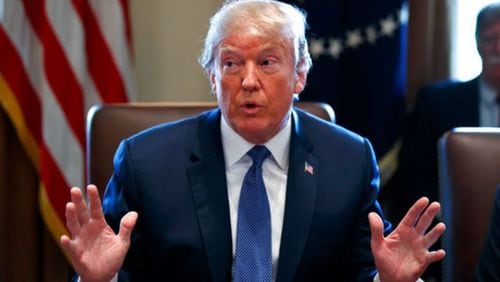President Donald Trump took to Twitter to bemoan what he considers unfair practices in the United States’ automobile trade with China.
His figures match up with international trade data. But economists raised some important details Trump omitted from his tweet, which put his claim in a slightly different light.
Trump's numbers are drawn from American and Chinese government trade data.
The United States does, in fact, pay a 25 percent tariff on cars sent to China, whereas China pays only 2.5 percent on cars coming into the United States.
But experts said his statement leaves out context.
For starters, China exports very few cars to the United States. China accounted for about 3 out of every 10,000 cars sold in the United States last year, according to Michael Hicks, the director of the Center for Business and Economic Research at Ball State University.
“For every car we import from China, we export six to China. None of those Chinese-produced cars is branded by a Chinese company (it is mostly Volvo),” Hicks said. “Our auto industry is doing extraordinarily well in China, while Chinese car production limps along.”
To illustrate China's relatively low share of car exports to the United States, Chad Bown, a senior fellow at the Peterson Institute for International Economics, pointed out data on U.S. imports from Mexico and Canada. Under the North American Free Trade Agreement, the United States, Mexico and Canada impose no tariffs.
“China exports very few cars to the U.S. So Trump’s Tweet is once again a bit of a red herring,” said Bown, who noted that a similar disparity exists when comparing Chinese car exports to the European Union, Japan or South Korea.
Some experts suggested Trump had cherry-picked the facts by singling out “cars” instead of a broader category of automobiles or car parts.
The U.S. tariff on light trucks from China is 25 percent, a legacy tariff dating from a trade dispute in the 1960s between the United States and several European countries, according to Gary Burtless, a senior fellow with the Brookings Institution.
“So by choosing ‘cars” but not ‘trucks’ in his Twitter example, Trump is cherry-picking products and not telling the entire story,” said Bown.
Gary Hufbauer, a fellow at the Peterson Institute, noted Chinese tariffs on American auto parts sent to China are well below 25 percent. For example, China places a 10 percent tariff on automobile engines. That’s significant because “U.S. firms often ship auto parts to China to be assembled there.”
Hicks noted the trade disparity stems in part from Trump’s decision to pull out of the Trans-Pacific Partnership, an Obama-era deal to lower trade barriers among a dozen countries. “So, had he not killed the TPP, whatever tariff distortions which now exist would have been reduced,” Hicks said.
Our ruling
American and Chinese government trade data support the numbers in Trump’s statement. However, Trump’s tweet ignored that China makes up a relatively small share of U.S. auto imports overall, and he didn’t tell the whole story by singling out cars rather than a broader category of related imports. One expert said Trump’s own trade policies have contributed to the disparity in car import tariffs.
We rate this Mostly True.
“When a car is sent to the United States from China, there is a Tariff to be paid of 2 1/2%. When a car is sent to China from the United States, there is a Tariff to be paid of 25%.”
— President Donald Trump on Monday, April 9, 2018 in in a tweet






